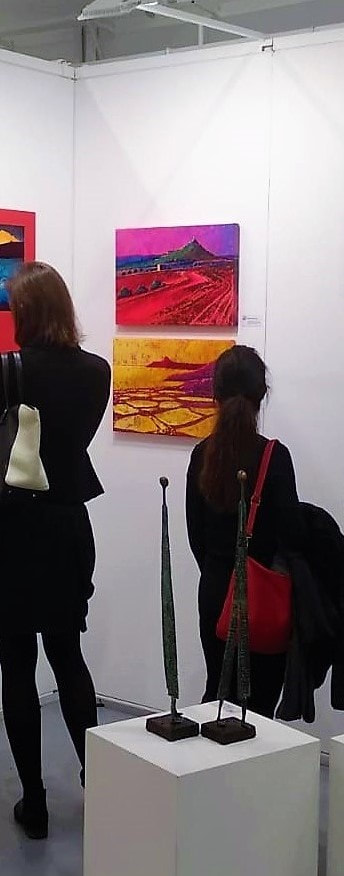
Aħmar formed part of a series of abstract works created by Christopher Saliba for the 2006 exhibition Of Time and Timelessness. These works were considered by the artist as a personal interpretation of the way memories and emotions are evoked by light, space, texture and colour.
“I paint energy and essence and my work is about time. I interpret memory by fragmenting my canvas into geometrical shapes, each of which is treated as an individual experience or memory in time.” Saliba lays down layers of colour on his canvasses representing the passage of time. From a distance, broad bands of colour, create a strong statement. Close up, the viewer finds textures and markings that continue to engage the eye. The artist rubbed and scraped away layers of paint to reveal different surfaces on the canvas, which may be compared to the way objects found in nature are worn away by the elements and the passage of time.
His paintings may be viewed as being either structurally built, or intuitive, spontaneous and impulsive. “There is the idea of accident,” explained Saliba, “the balance between the order and unpredicted facts.” Accidental and unintended happenings throughout the working process reflect the fact that the passage of memory is not simply chronological, linear or rational. The work narrates nothing but its own story.
Whilst the works differ from Rothko in painterly technique, Rothko’s idea that “a painting is not about an experience. It is an experience” is apt when viewing the work Aħmar by Saliba.
The text above is an extract from www.kreattivita.org:
https://www.kreattivita.org/en/christopher-saliba/?fbclid=IwAR3cFzLUayEM1Hz2oz93YQpyrWCxp-ZXV0fDxETmFoibIVlwEfKrt0Lp6jM
“I paint energy and essence and my work is about time. I interpret memory by fragmenting my canvas into geometrical shapes, each of which is treated as an individual experience or memory in time.” Saliba lays down layers of colour on his canvasses representing the passage of time. From a distance, broad bands of colour, create a strong statement. Close up, the viewer finds textures and markings that continue to engage the eye. The artist rubbed and scraped away layers of paint to reveal different surfaces on the canvas, which may be compared to the way objects found in nature are worn away by the elements and the passage of time.
His paintings may be viewed as being either structurally built, or intuitive, spontaneous and impulsive. “There is the idea of accident,” explained Saliba, “the balance between the order and unpredicted facts.” Accidental and unintended happenings throughout the working process reflect the fact that the passage of memory is not simply chronological, linear or rational. The work narrates nothing but its own story.
Whilst the works differ from Rothko in painterly technique, Rothko’s idea that “a painting is not about an experience. It is an experience” is apt when viewing the work Aħmar by Saliba.
The text above is an extract from www.kreattivita.org:
https://www.kreattivita.org/en/christopher-saliba/?fbclid=IwAR3cFzLUayEM1Hz2oz93YQpyrWCxp-ZXV0fDxETmFoibIVlwEfKrt0Lp6jM







 RSS Feed
RSS Feed
